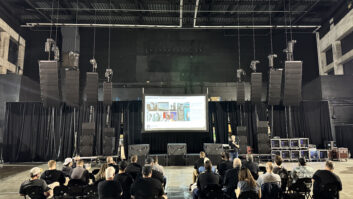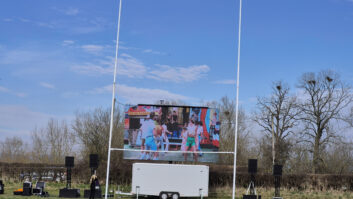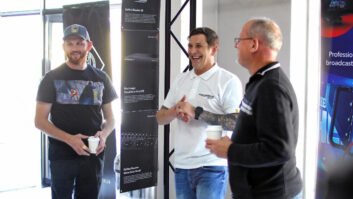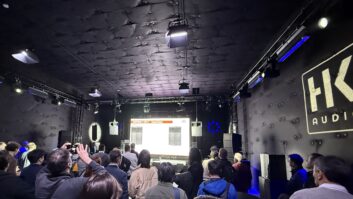 With the vast number of online stores and e-commerce transactions taking place daily, in-store shopping is much more about the overall experience than about necessity these days. Companies spend a lot of effort developing their brands in parallel to their products to entice customers to buy their merchandise instead of their competitors’, and that branding effort extends into their stores as well. From the colour scheme to lighting to artwork, very little is left to chance. Audio has an equal, if not greater, impact on our buying habits than visual stimuli.
With the vast number of online stores and e-commerce transactions taking place daily, in-store shopping is much more about the overall experience than about necessity these days. Companies spend a lot of effort developing their brands in parallel to their products to entice customers to buy their merchandise instead of their competitors’, and that branding effort extends into their stores as well. From the colour scheme to lighting to artwork, very little is left to chance. Audio has an equal, if not greater, impact on our buying habits than visual stimuli.
That’s because audio is one of our primary senses for triggering fight or flight responses. Our “lizard” brain from the dawn of time is conditioned so that when audio stops or our environment gets very quiet, we subconsciously take it as an indication that danger is nearby. Granted, you’re not likely to be mauled by a tiger in the middle of a clothing store, but people often feel uncomfortable or unsettled in store environments when background music or other noise is absent. When background music is playing, we relax and can focus on our shopping rather than looking for reasons to exit the space.
Target made headlines in 2017 when it announced plans to start playing music in its stores nationwide. “It’s all about activating all the senses while guests are in the store,” Target communications lead Kristy Welker said. “Guests enjoy it as part of the shopping experience. When we first started testing it and asking guests what they think, some of them even wondered if we had it there before.”
When planning an audio experience for a new retail space or optimising an already existing system, here’s what to consider:
Reinforce the Store Brand
When selecting music for a retail space, it needs to reflect and reinforce the brand. What music choices align with the visual design of the store and its customers’ interests? This consideration is imperative as playing music that is perceived as complementary to a brand can boost sales by as much as 5%. Conversely, music that clashes with the brand has shown to reduce sales by as much as 4%. A study carried out on over 1,000 UK shoppers revealed that one out of two shoppers had left a store due to annoying background music.
Choose the Right Musical Genre
Research shows that music can influence what shoppers choose and how much they buy. A 2005 study revealed that people tend to spend more on impulse buys when pleasant music is playing. The effect was present even when people did not notice the music playing in the store, showing that music has a subconscious effect on shopping habits. More interestingly, the type of music played can act as a trigger for specific purchases. Classical music, for example, has been found to influence shoppers to buy more expensive items. Scientists believe that it may be because classical music evokes feelings of high quality and elegance and thus influences shopping decisions in that direction.
Set the Pace
Studies show that the speed, rhythm and volume of in-store music affects the pace of customer flow through the store. When calm, slower music is playing, people tend to wander around the store slowly; on the other hand, when energetic, loud songs are playing, people tend to accelerate their pace through the store. In-store music strategies should take these effects into account, possibly playing different tempos based on the time of the day and desired goals. For example, a retailer may decide to play louder fast-tempo music when it’s close to closing time to encourage customers to speed through the store; conversely, slow music could be played during off-peak times to inspire shoppers to wander around and browse the merchandise for longer. Research indicates that the length of time a shopper spends in the store is commensurate with how much they spend, increasing sales by up to 38%. While this correlation may seem obvious, audio is still a commonly overlooked brand decision.
Don’t Forget about Store Employees
Background music impacts not only customers but employees as well. Well-curated music can be a great way to boost staff morale, concentration and productivity. In a 2013 research by DJS, 77% of businesses agreed that their staff is more productive when music is playing. Other studies support that people tend to work faster with greater accuracy and creativity when listening to music. Having a large catalog of music to iterate through or randomise will prevent employees from recognising patterns and becoming bored with the selection.
Loudspeaker Selection and Installation
Working with a thoughtful and thorough sound system integrator and an experienced AV consultant is essential during planning and installation. The integrator will take into consideration the minute details required to ensure the sound system elevates the retail space. A great integrator will have specific knowledge of the systems that are needed and be able to provide cutting-edge industry solutions to any problems that may arise.
Determining which loudspeakers are best suited to each retail application comes down to the architectural demands of the space. In a venue with open and reverberant spaces, selecting a loudspeaker with specific directivity and high intelligibility is key. Working with an acoustic consultant to model the room’s acoustics can also be of significant benefit to both loudspeaker selection and placement.
When Bared Footwear decided to open a flagship store in Sydney, Australia’s Central Business District, they wanted to implement a sound system that ensured every shopper was immersed in the space. The two-story location features high ceilings, timber flooring and floor-to-ceiling windows, and while the open spaces and sleek architectural details cultivated an inviting atmosphere, they complicated sound coverage and intelligibility for the in-store live music and DJ performances. To accommodate for the AV challenges and address the need for an impeccable sound system for live music, seven loudspeakers were strategically distributed around the store to deliver high sonic performance and intelligibility. The compact loudspeakers disappeared into the background of the space, preserving the comfortable and stylish aesthetic the store desired while helping Bared Footwear create an ideal shopping experience.
Experiential Shopping
Today’s in-store shopping needs to be experiential; the more a customer is immersed in the ambiance, the more likely they are to return in the future for repeat business. Audio and acoustics play a key role in the customer experience and overall satisfaction. When a customer recalls a retail experience as exceptional, they are more likely to refer family and friends to the store.







